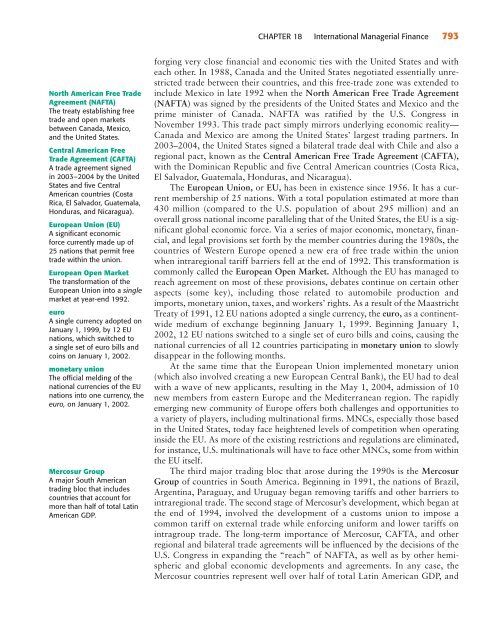Chapter 18 International Managerial Finance
Chapter 18 International Managerial Finance
Chapter 18 International Managerial Finance
Create successful ePaper yourself
Turn your PDF publications into a flip-book with our unique Google optimized e-Paper software.
North American Free Trade<br />
Agreement (NAFTA)<br />
The treaty establishing free<br />
trade and open markets<br />
between Canada, Mexico,<br />
and the United States.<br />
Central American Free<br />
Trade Agreement (CAFTA)<br />
A trade agreement signed<br />
in 2003–2004 by the United<br />
States and five Central<br />
American countries (Costa<br />
Rica, El Salvador, Guatemala,<br />
Honduras, and Nicaragua).<br />
European Union (EU)<br />
A significant economic<br />
force currently made up of<br />
25 nations that permit free<br />
trade within the union.<br />
European Open Market<br />
The transformation of the<br />
European Union into a single<br />
market at year-end 1992.<br />
euro<br />
A single currency adopted on<br />
January 1, 1999, by 12 EU<br />
nations, which switched to<br />
a single set of euro bills and<br />
coins on January 1, 2002.<br />
monetary union<br />
The official melding of the<br />
national currencies of the EU<br />
nations into one currency, the<br />
euro, on January 1, 2002.<br />
Mercosur Group<br />
A major South American<br />
trading bloc that includes<br />
countries that account for<br />
more than half of total Latin<br />
American GDP.<br />
CHAPTER <strong>18</strong> <strong>International</strong> <strong>Managerial</strong> <strong>Finance</strong> 793<br />
forging very close financial and economic ties with the United States and with<br />
each other. In 1988, Canada and the United States negotiated essentially unrestricted<br />
trade between their countries, and this free-trade zone was extended to<br />
include Mexico in late 1992 when the North American Free Trade Agreement<br />
(NAFTA) was signed by the presidents of the United States and Mexico and the<br />
prime minister of Canada. NAFTA was ratified by the U.S. Congress in<br />
November 1993. This trade pact simply mirrors underlying economic reality—<br />
Canada and Mexico are among the United States’ largest trading partners. In<br />
2003–2004, the United States signed a bilateral trade deal with Chile and also a<br />
regional pact, known as the Central American Free Trade Agreement (CAFTA),<br />
with the Dominican Republic and five Central American countries (Costa Rica,<br />
El Salvador, Guatemala, Honduras, and Nicaragua).<br />
The European Union, or EU, has been in existence since 1956. It has a current<br />
membership of 25 nations. With a total population estimated at more than<br />
430 million (compared to the U.S. population of about 295 million) and an<br />
overall gross national income paralleling that of the United States, the EU is a significant<br />
global economic force. Via a series of major economic, monetary, financial,<br />
and legal provisions set forth by the member countries during the 1980s, the<br />
countries of Western Europe opened a new era of free trade within the union<br />
when intraregional tariff barriers fell at the end of 1992. This transformation is<br />
commonly called the European Open Market. Although the EU has managed to<br />
reach agreement on most of these provisions, debates continue on certain other<br />
aspects (some key), including those related to automobile production and<br />
imports, monetary union, taxes, and workers’ rights. As a result of the Maastricht<br />
Treaty of 1991, 12 EU nations adopted a single currency, the euro, as a continentwide<br />
medium of exchange beginning January 1, 1999. Beginning January 1,<br />
2002, 12 EU nations switched to a single set of euro bills and coins, causing the<br />
national currencies of all 12 countries participating in monetary union to slowly<br />
disappear in the following months.<br />
At the same time that the European Union implemented monetary union<br />
(which also involved creating a new European Central Bank), the EU had to deal<br />
with a wave of new applicants, resulting in the May 1, 2004, admission of 10<br />
new members from eastern Europe and the Mediterranean region. The rapidly<br />
emerging new community of Europe offers both challenges and opportunities to<br />
a variety of players, including multinational firms. MNCs, especially those based<br />
in the United States, today face heightened levels of competition when operating<br />
inside the EU. As more of the existing restrictions and regulations are eliminated,<br />
for instance, U.S. multinationals will have to face other MNCs, some from within<br />
the EU itself.<br />
The third major trading bloc that arose during the 1990s is the Mercosur<br />
Group of countries in South America. Beginning in 1991, the nations of Brazil,<br />
Argentina, Paraguay, and Uruguay began removing tariffs and other barriers to<br />
intraregional trade. The second stage of Mercosur’s development, which began at<br />
the end of 1994, involved the development of a customs union to impose a<br />
common tariff on external trade while enforcing uniform and lower tariffs on<br />
intragroup trade. The long-term importance of Mercosur, CAFTA, and other<br />
regional and bilateral trade agreements will be influenced by the decisions of the<br />
U.S. Congress in expanding the “reach” of NAFTA, as well as by other hemispheric<br />
and global economic developments and agreements. In any case, the<br />
Mercosur countries represent well over half of total Latin American GDP, and
















